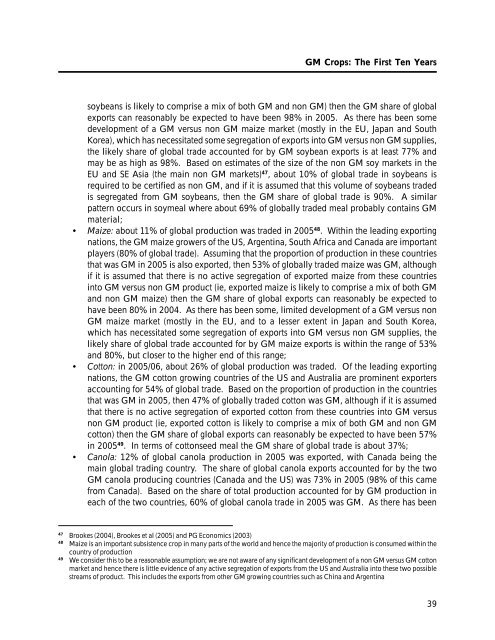GM Crops: The First Ten Years - International Service for the ...
GM Crops: The First Ten Years - International Service for the ...
GM Crops: The First Ten Years - International Service for the ...
You also want an ePaper? Increase the reach of your titles
YUMPU automatically turns print PDFs into web optimized ePapers that Google loves.
<strong>GM</strong> <strong>Crops</strong>: <strong>The</strong> <strong>First</strong> <strong>Ten</strong> <strong>Years</strong><br />
soybeans is likely to comprise a mix of both <strong>GM</strong> and non <strong>GM</strong>) <strong>the</strong>n <strong>the</strong> <strong>GM</strong> share of global<br />
exports can reasonably be expected to have been 98% in 2005. As <strong>the</strong>re has been some<br />
development of a <strong>GM</strong> versus non <strong>GM</strong> maize market (mostly in <strong>the</strong> EU, Japan and South<br />
Korea), which has necessitated some segregation of exports into <strong>GM</strong> versus non <strong>GM</strong> supplies,<br />
<strong>the</strong> likely share of global trade accounted <strong>for</strong> by <strong>GM</strong> soybean exports is at least 77% and<br />
may be as high as 98%. Based on estimates of <strong>the</strong> size of <strong>the</strong> non <strong>GM</strong> soy markets in <strong>the</strong><br />
EU and SE Asia (<strong>the</strong> main non <strong>GM</strong> markets) 47 , about 10% of global trade in soybeans is<br />
required to be certified as non <strong>GM</strong>, and if it is assumed that this volume of soybeans traded<br />
is segregated from <strong>GM</strong> soybeans, <strong>the</strong>n <strong>the</strong> <strong>GM</strong> share of global trade is 90%. A similar<br />
pattern occurs in soymeal where about 69% of globally traded meal probably contains <strong>GM</strong><br />
material;<br />
• Maize: about 11% of global production was traded in 2005 48 . Within <strong>the</strong> leading exporting<br />
nations, <strong>the</strong> <strong>GM</strong> maize growers of <strong>the</strong> US, Argentina, South Africa and Canada are important<br />
players (80% of global trade). Assuming that <strong>the</strong> proportion of production in <strong>the</strong>se countries<br />
that was <strong>GM</strong> in 2005 is also exported, <strong>the</strong>n 53% of globally traded maize was <strong>GM</strong>, although<br />
if it is assumed that <strong>the</strong>re is no active segregation of exported maize from <strong>the</strong>se countries<br />
into <strong>GM</strong> versus non <strong>GM</strong> product (ie, exported maize is likely to comprise a mix of both <strong>GM</strong><br />
and non <strong>GM</strong> maize) <strong>the</strong>n <strong>the</strong> <strong>GM</strong> share of global exports can reasonably be expected to<br />
have been 80% in 2004. As <strong>the</strong>re has been some, limited development of a <strong>GM</strong> versus non<br />
<strong>GM</strong> maize market (mostly in <strong>the</strong> EU, and to a lesser extent in Japan and South Korea,<br />
which has necessitated some segregation of exports into <strong>GM</strong> versus non <strong>GM</strong> supplies, <strong>the</strong><br />
likely share of global trade accounted <strong>for</strong> by <strong>GM</strong> maize exports is within <strong>the</strong> range of 53%<br />
and 80%, but closer to <strong>the</strong> higher end of this range;<br />
• Cotton: in 2005/06, about 26% of global production was traded. Of <strong>the</strong> leading exporting<br />
nations, <strong>the</strong> <strong>GM</strong> cotton growing countries of <strong>the</strong> US and Australia are prominent exporters<br />
accounting <strong>for</strong> 54% of global trade. Based on <strong>the</strong> proportion of production in <strong>the</strong> countries<br />
that was <strong>GM</strong> in 2005, <strong>the</strong>n 47% of globally traded cotton was <strong>GM</strong>, although if it is assumed<br />
that <strong>the</strong>re is no active segregation of exported cotton from <strong>the</strong>se countries into <strong>GM</strong> versus<br />
non <strong>GM</strong> product (ie, exported cotton is likely to comprise a mix of both <strong>GM</strong> and non <strong>GM</strong><br />
cotton) <strong>the</strong>n <strong>the</strong> <strong>GM</strong> share of global exports can reasonably be expected to have been 57%<br />
in 2005 49 . In terms of cottonseed meal <strong>the</strong> <strong>GM</strong> share of global trade is about 37%;<br />
• Canola: 12% of global canola production in 2005 was exported, with Canada being <strong>the</strong><br />
main global trading country. <strong>The</strong> share of global canola exports accounted <strong>for</strong> by <strong>the</strong> two<br />
<strong>GM</strong> canola producing countries (Canada and <strong>the</strong> US) was 73% in 2005 (98% of this came<br />
from Canada). Based on <strong>the</strong> share of total production accounted <strong>for</strong> by <strong>GM</strong> production in<br />
each of <strong>the</strong> two countries, 60% of global canola trade in 2005 was <strong>GM</strong>. As <strong>the</strong>re has been<br />
47 Brookes (2004), Brookes et al (2005) and PG Economics (2003)<br />
48 Maize is an important subsistence crop in many parts of <strong>the</strong> world and hence <strong>the</strong> majority of production is consumed within <strong>the</strong><br />
country of production<br />
49 We consider this to be a reasonable assumption; we are not aware of any significant development of a non <strong>GM</strong> versus <strong>GM</strong> cotton<br />
market and hence <strong>the</strong>re is little evidence of any active segregation of exports from <strong>the</strong> US and Australia into <strong>the</strong>se two possible<br />
streams of product. This includes <strong>the</strong> exports from o<strong>the</strong>r <strong>GM</strong> growing countries such as China and Argentina<br />
39
















